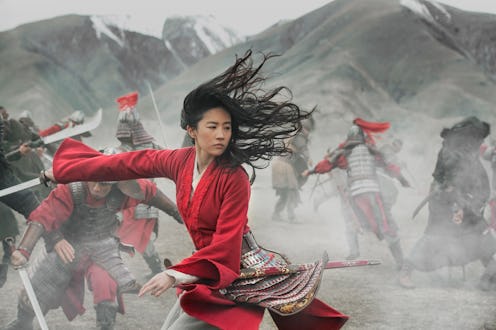Entertainment
The Differences Between The New 'Mulan' & The Animated Classic, Explained

The live-action version of Mulan might still be swift as a coursing river, but will she have the force of a great typhoon? Fans of Disney's 1998 animated classic don't need to worry about the character of Mulan changing too much. But there will be some striking differences between the live-action Mulan and the animated classic.
Unlike Disney's last few live-action adaptations — Aladdin and The Lion King — Mulan is not going to be a scene-by-scene remake of the animated film. And that's on purpose. "We went all the way back to the original 'Ballad of Mulan,' and to the many variations of that ballad that have been told in China since it was originally created," producer Jason Reed tells Bustle. And, as it turns out, Disney took a lot of liberties when adapting that original story in 1998 — including incorporating many Americanizations that Chinese audiences could find offensive.
That includes Mushu, Mulan's beloved dragon sidekick. The live-action team opted to not include the Mushu character in the new film because as Reed explains, "Using [a dragon] as a silly sidekick didn't play very well with the traditional Chinese audience."
But that's not the only change audiences can expect. Here, we breakdown some of the key updates made to the live-action film.
The Villain
In 1998's Mulan, the Chinese army fought against an invading Hun Army led by Shan Yu. In the 2020 film, Mulan will be fighting against a new villain, Bori Khan and his Rouran army, who are trying to reclaim their land. The distinction is significant, as it more accurately reflects the original "Ballad of Mulan." "Bori Khan's fight is to regain and recompose his culture of the Rouran Khanate," says actor Jason Scott Lee, who plays Khan.
Moreover, instead of his hawk sidekick, Khan has a much more powerful and threatening ally, the witch Xian Lang, played by Gong Li. "We wanted to have a female antagonist in the movie as well as just having a male antagonist so that we could explore female power in that society in different ways, and have different perspectives on it," says Reed.
Mulan's Hair
If you've seen a trailer for Mulan, you've probably noticed that Mulan is rocking her long hair in battle. Meaning, fans can say goodbye to the iconic Mulan cutting her hair scene. And there's actually a very specific reason for why the live action Mulan doesn't symbolically chop off her hair with her father's sword. "In the Disney film, the scene where she's cutting her hair off, it's actually an anachronism," Reed explains. "Chinese warriors, male warriors, wore their hair long [so] for her to cut her hair off, it would make her look more like a woman."
The Love Interest
Li Shang is no more. Instead, Disney decided to break the soldier into two different characters: Commander Tung (Donnie Yen), and Mulan's new love interest Chen Honghui (Yoson An). The decision to change the love interest was, according to Reed, influenced by the #MeToo movement. "Having a commanding officer that is also the sexual love interest was very uncomfortable, and we didn't think it was appropriate," he says. This time around, Honghui is Mulan's equal in the army, removing the problematic power dynamic.
The Songs
Mulan will not be a musical. That said, there will still be familiar tunes throughout the movie. "I can guarantee you that there will be songs you recognize and remember," says Reed. And so far that promise rings true: the trailers for Mulan have already used an instrumental version of the animated film's classic ballad, "Reflection."
This article was originally published on